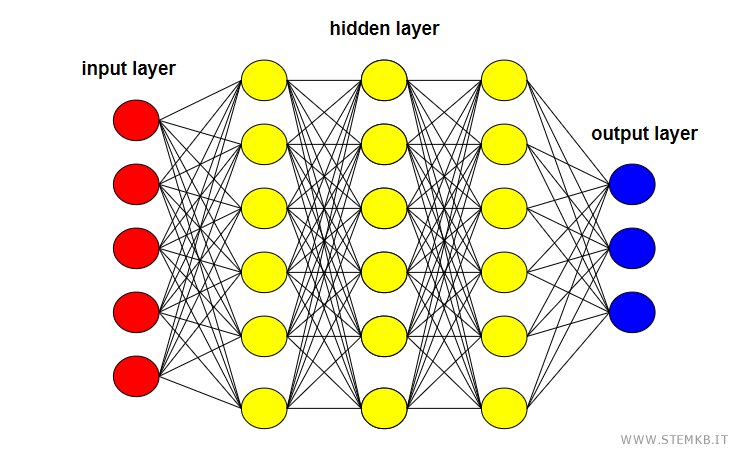Deep Learning
Deep learning is a sophisticated branch of machine learning, leveraging neural networks for complex data processing. This methodology is described as "deep" due to its reliance on training through multiple hidden layers within an extensive neural network.
Deep neural networks are intricately structured with multiple layers of nodes or 'artificial neurons'. Each layer is designed to receive input from its predecessor, process this information, and then relay the output to the subsequent layer. This sequential layering allows the model to adeptly learn and represent complex feature hierarchies from the data it's fed.
Typically, a deep learning neural network includes at least two hidden intermediate layers, or hidden layers, complementing the initial input layer and the concluding output layer. Networks with this configuration are known as deep neural networks.

At the input layer, the network receives data, which is then processed through successive layers. Each layer in the neural network is responsible for computing values for the subsequent layer. The process culminates at the output layer, where the final output is generated.
At the fundamental levels of these networks, simpler characteristics are learned, such as edges or angles within an image. As information progresses through the network, the deeper layers develop the capability to recognize and interpret more sophisticated and abstract concepts, ranging from distinct objects to comprehensive scenes.
These networks are characterized by their hierarchical learning approach. The initial layers focus on elementary aspects, while the advanced layers delve into more nuanced and intricate elements.
The training of a deep neural network relies on a pivotal algorithm known as backpropagation. This mechanism fine-tunes the network's weights by analyzing the error in the output phase and iteratively optimizes the model. It accomplishes this through a sophisticated process called gradient descent, ensuring that the network evolves and improves in accuracy and efficiency.
In neural networks, each node is intricately connected to mathematical functions, known as activation functions. These functions play a pivotal role in deciding if and to what extent a neuron should "activate," influencing the next layer in the process. Popular examples of these functions include the ReLU (Rectified Linear Unit) and the Sigmoid.
Applications of Deep Learning. The use of deep learning spans a range of applications including character and image recognition, driverless vehicle technology, computer vision, natural language processing, and across various facets of automated machine learning. Deep Learning has brought about a paradigm shift in fields such as speech recognition, computer vision, and machine translation, to name a few. Its prowess lies in its ability to process extensive data volumes and learn intricate features directly from this data, eliminating the need for manual programming.
Deep learning comprises diverse techniques and algorithms, each contributing to its expansive application spectrum.
- Convolutional Neural Networks (CNNs)
Convolutional Neural Networks (CNNs) shine in processing data structured in a grid, like images. These networks use convolutional filters that glide over images, extracting pivotal features like edges, textures, and various visual elements. - Recurrent Neural Networks (RNNs)
Recurrent Neural Networks (RNNs) are best suited for sequential data, such as text or time-series analysis. They have a unique capability to "remember" previous information, which renders them ideal for tasks like machine translation or text generation. - Transfer Learning
Transfer Learning is a technique where a model, initially trained on a broad dataset, is later fine-tuned with a more specific dataset. This method is particularly effective when the available training data is limited. - Generative Adversarial Networks (GANs)
Utilizing a duo of models, a generator and a discriminator, Generative Adversarial Networks operate in a unique push-and-pull dynamic. The generator fabricates data mimicking real-world information, while the discriminator hones its ability to distinguish between the authentic and the artificial. This innovative technique has gained acclaim for its prowess in crafting lifelike images. - Autoencoders
Autoencoders stand out in the realm of unsupervised learning. These neural networks master the art of data compression, distilling information into a more compact, lower-dimensional form, and then reconstructing it. Their goal is to preserve the essence of the original data to the highest degree possible. - Deep Reinforcement Learning
A fusion of deep learning and reinforcement learning, Deep Reinforcement Learning creates systems equipped to navigate and make optimal decisions within intricate environments. Its most notable triumphs include mastering the strategic depths of the game Go and steering the course for autonomous vehicles. - Capsule Networks
Capsule Networks are designed to address specific challenges faced by traditional CNNs, especially in managing spatial relationships and rotations in image processing. By employing capsules - clusters of neurons - these networks provide a more nuanced understanding of these complex interactions. - Distributed Representations
In the field of computational linguistics, distributed representations like Word2Vec or BERT are pivotal. They empower models to capture the intricate web of semantic and syntactic relationships between words, offering a deeper insight into language processing. - Sparse Neural Networks
Mimicking the sparse connectivity of neural pathways in the human brain, Sparse Neural Networks aim for greater computational efficiency. By streamlining network complexity, these models offer a more refined approach to neural network design. - Syntactic Neural Networks (SyNets)
Syntactic Neural Networks, or SyNets, represent an avant-garde fusion of neural network technology with symbolic programming. This hybrid approach holds promise for surmounting some of the inherent limitations in deep learning, particularly in tasks involving intricate reasoning and comprehension. - Federated Learning
Federated Learning introduces a novel paradigm in machine learning. By distributing the training process across numerous devices while keeping data decentralized, it significantly elevates the standards of data privacy and security.

